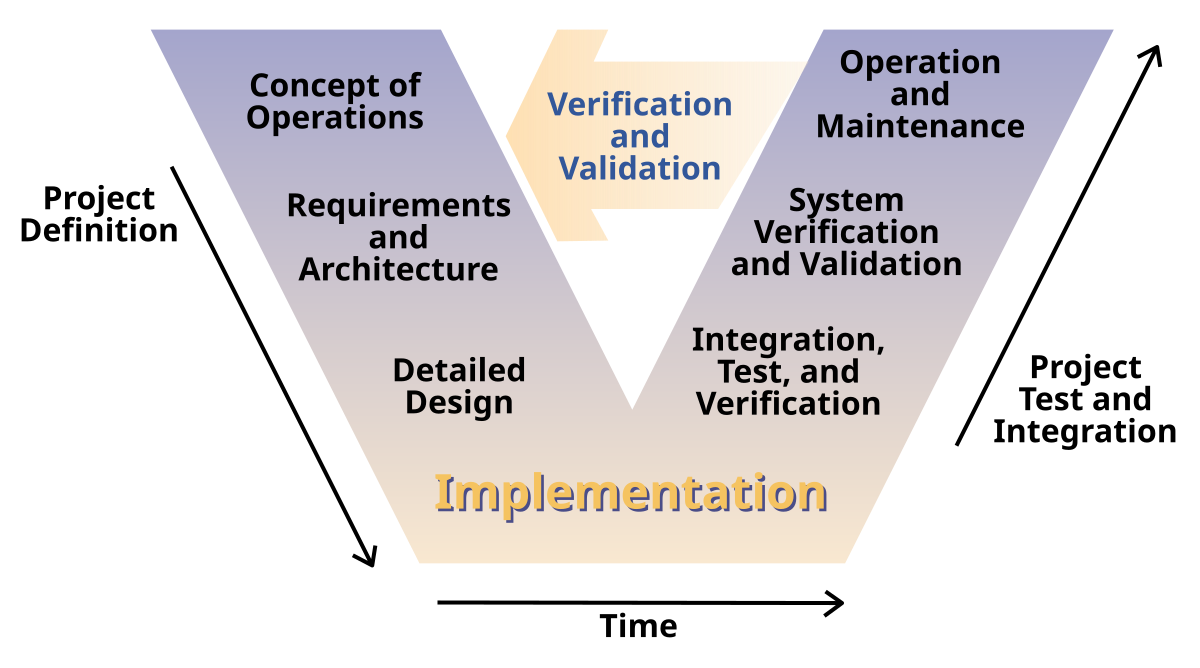 | ||
The V-model is a term applied to a range of models, from a conceptual model designed to produce a simplified understanding of the complexity associated with systems development to detailed, rigorous development lifecycle models and project management models.
Contents
- Overview
- Objectives
- Systems engineering and verification
- Specification stream
- Testing stream
- Applications
- Advantages
- Limits
- References
There are several radically different forms of the V-model, and this creates considerable confusion. The V-model falls into three broad categories.
First there is the German V-Model "Das V-Modell", the official project management methodology of the German government. It is roughly equivalent to PRINCE2, but more directly relevant to software development. The key attribute of using a "V" representation was to require proof that the products from the left-side of the V were acceptable by the appropriate test and integration organization implementing the right-side of the V.
In the UK and throughout the testing community worldwide, the V-model is widely seen as a vaguer illustrative depiction of the software development process as described in the International Software Testing Qualifications Board Foundation Syllabus for software testers. There is no single accepted definition of this model, which is more directly covered in the alternative article on the V-Model (software development). There are therefore multiple variations of this version. This problem must be borne in mind when discussing the V-model.
The US also has a government standard V-model which dates back about 20 years like its German counterpart. Its scope is a narrower systems development lifecycle model, but far more detailed and more rigorous than most UK practitioners and testers would understand by the V-model.
Overview
The V-model is a graphical representation of the systems development lifecycle. It summarizes the main steps to be taken in conjunction with the corresponding deliverables within computerized system validation framework.
The V represents the sequence of steps in a project life cycle development. It describes the activities to be performed and the results that have to be produced during product development. The left side of the "V" represents the decomposition of requirements, and creation of system specifications. The right side of the V represents integration of parts and their validation. However, Requirements need to be validated first against the higher level requirements or user needs. Furthermore, there is also something as validation of system models (e.g. FEM). This can partially be done at the left side also. To claim that validation only occurs at the right side may not be correct. The easiest way is to say that verification is always against the requirements (technical terms) and validation always against the real world or the user needs.
It is sometimes said that validation can be expressed by the query "Are you building the right thing?" and verification by "Are you building it right?"
In practice, the usage of these terms varies. Sometimes they are even used interchangeably.
The PMBOK guide, an IEEE standard (jointly maintained by INCOSE, the Systems engineering Research Council SERC, and IEEE Computer Society) defines them as follows in its 4th edition:
Objectives
The V-model provides guidance for the planning and realization of projects. The following objectives are intended to be achieved by a project execution:
Systems engineering and verification
The systems engineering process (SEP) provides a path for improving the cost effectiveness of complex systems as experienced by the system owner over the entire life of the system, from conception to retirement.
It involved early and comprehensive identification of goals, a concept of operations that describes user needs and the operating environment, thorough and testable system requirements, detailed design, implementation, rigorous acceptance testing of the implemented system to ensure it meets the stated requirements (system verification), measuring its effectiveness in addressing goals (system validation), on-going operation and maintenance, system upgrades over time, and eventual retirement.
The process emphasizes requirements-driven design and testing. All design elements and acceptance tests must be traceable to one or more system requirements and every requirement must be addressed by at least one design element and acceptance test. Such rigor ensures nothing is done unnecessarily and everything that is necessary is accomplished.
Specification stream
The specification stream mainly consists of:
Testing stream
The testing stream generally consists of:
The development stream can consist (depending on the system type and the development scope) of customization, configuration or coding.
Applications
The V-model is used to regulate the software development process within the German federal administration. Nowadays it is still the standard for German federal administration and defense projects, as well as software developers within the region.
The concept of the V-model was developed simultaneously, but independently, in Germany and in the United States in the late 1980s:
It has now found widespread application in commercial as well as defense programs. Its primary use is in project management and throughout the project lifecycle.
One fundamental characteristic of the US V-model is that time and maturity move from left to right and one cannot move back in time. All iteration is along a vertical line to higher or lower levels in the system hierarchy, as shown in the figure. This has proven to be an important aspect of the model. The expansion of the model to a dual-Vee concept is treated in reference.
As the V-model is publicly available many companies also use it. In project management it is a method comparable to PRINCE2 and describes methods for project management as well as methods for system development. The V-Model while rigid in process, can be very flexible in application, especially as it pertains to the scope outside of the realm of the System Development Lifecycle normal parameters.
Advantages
These are the advantages V-model offers in front of other systems development models:
Limits
The following aspects are not covered by the V-model, they must be regulated in addition, or the V-Model must be adapted accordingly:
